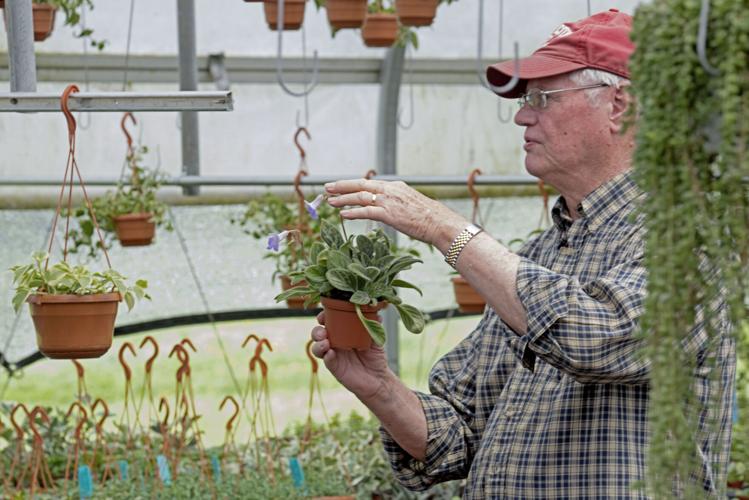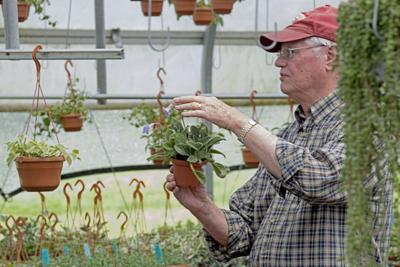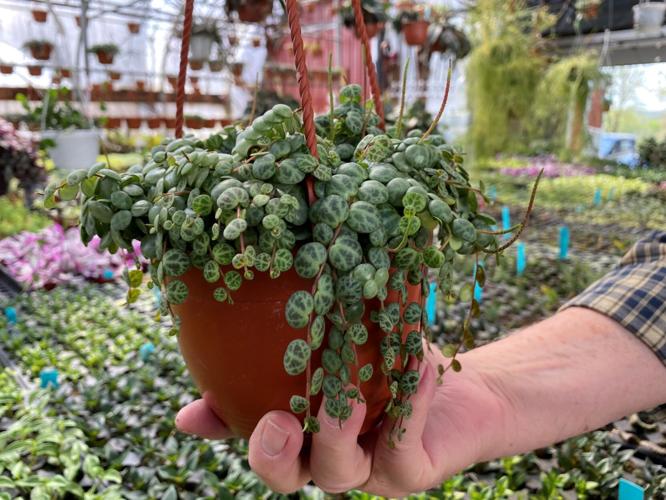There’s a corner of the houseplant world on leaf watch. Will each new leaf unfurl to reveal a rare color, pattern or variegation? Maybe a new mutation? These rarities are common inside a trio of greenhouses not too far from the Susquehanna River.
The home of Gary’s Specialty Plants is a mecca for plant parents. Pink variegated string of hearts and rare string of turtles dangle from tiny baskets overhead. Below, mini Swiss cheese plant, tri-color tradescantia and succulents grow in itty-bitty pots. About 300,000 tiny plants will be sold wholesale and sent to garden centers throughout the east coast this year. With the houseplant boom still going, Gary Hunter and his plants are in demand.
Every weekend, they take a look at inventory and send out a note to customers Monday morning. By around lunchtime, every last plant’s sold.
Annuals to uncommon
Gary started a different kind of plant business in 1973. He spent 35 years growing annuals at Hunter’s Greenhouse in Drumore Township. But that ended with the Great Recession.
After a year working at Longwood Gardens, Gary starting growing again with miniature and specialty houseplants.
What exactly is a specialty plant?
“If you don’t have one, it’s rare, right?” Gary says with a laugh.
Often that means a smaller version of a common plant. There are also plants with mutations turning leaves pink, variegated or adding holes in leaves. Others are uncommon plants.
“Commercial growers, the big guys, don’t pay attention to collector plants,” Gary says. “They want to grow a thousand petunias.”

Take the Asian violet, or primulina.
“This doesn’t flower when it’s a little plant. Sometimes it takes a year or more to flower,” he says. “So that’s not a commercial crop. Flowering plants need to be in flower or nobody buys them.”
Gary heard about primulina through The Gesneriad Society, a group dedicated to the plant family whose best-known member is the African violet.
“My position is they’re better than African violets,” Gary says. “You grow them the same only they’re tougher.”
He propagates several varieties of Asian violets. An early favorite, Loki, has green leaves with silver veins and delicate blue flowers.
Another, Party Dress, flowers a little quicker than others.
Lots of little plants
Gary’s plants fill about 7,000 square feet of greenhouse space, small compared to some of the county’s biggest operations. Still, in that space, about 300,000 plants are sold annually. The greenhouse’s bright blue plant tags can be spotted at Longwood Gardens’ store, Pennsylvania Horticultural Society’s store at the Philadelphia Flower Show and Madcap & Co.
Since the Queen Street gift shop starting selling Gary’s plants four years ago, they’ve sold out fast, says owner Marty Hulse. Chinese money plant (Pilea peperomioides), succulents and Swiss cheese plant (monstera) have been especially popular.
“It really doesn’t matter what it is, people will buy it,” Hulse says.
He appreciates the quality of the plants and supporting a local grower.

Propagating plants
Gary’s plants start in one greenhouse, where unrooted cuttings are planted. Some of the cuttings come from Gary’s own stock (not-so-tiny plants labeled “do not sell”). Others come from around the world.
“We get succulents from Mexico. These came from Guatemala,” he says, pointing to dozens of purple passion plants.
Gary selects the plants and then turns them over to Joe King, who runs the greenhouses and grows the plants.
“It takes a lot of work,” King says.
As the plants grow their own roots, they move to another greenhouse filled with 2.5-inch pots of begonias, sedum, oxalis and peperomia.

Last year’s top plant was string of hearts, Ceropegia woodii.
Gary points out one with green and silver leaves. Another has more silver in the leaves.
“We’ve never had enough of this, every time,” Gary says.
“That’s the number one question: Do you have any string of hearts?” says Val O’Donnell, operations manager.
One type they call pretty pink string of hearts. The pink color is a mutation that usually stays true when cuttings grow into their own plants. The crew have spent three years propagating plants from their own large stock plants. Gary’s working with brokers in the hopes of propagating more in Central America.

Sinningia ‘Li’l Georgie is one of the smallest houseplants in the world. Gary's trying to find a way to grow more. “This is one of my lifetime projects,” he says.
A lifetime project
As Gary’s traded common plants for what he calls interesting plants, the learning curve to grow can be steep.
Take Sinningia ‘Li’l Georgie,’ one of the smallest houseplants in the world. At maturity, the leaves don’t grow more than an inch. He bought one of these miniature plants and realized it could be grown on a windowsill.
“The breakthrough was this can grow out in the open,” he says. “It doesn’t have to be in a terrarium with extra humidity.”
However, the hybrid plant is sterile with no seed. Sinningia can be propagated by dividing but that would take years to grow many more tiny plants. Another option is tissue culture, but neither Gary or Joe have a sterile lab.
Gary found a partner at a university lab but the professor died. He connected with a commercial lab that went bankrupt. There’s another university program but his contact has been silent during the pandemic.
Just as some plant collectors are willing to pay top dollar for pink, heart-shaped leaves, Gary’s willing to take the time to grow more ‘Li’l Georgies.’
“This is one of my lifetime projects,” he says.






 ERIN NEGLEY | Staff Writer
ERIN NEGLEY | Staff Writer















